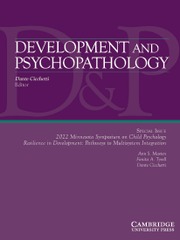No CrossRef data available.
Article contents
Bidirectional relation of self-regulation with oppositional defiant disorder symptom networks and moderating role of gender
Published online by Cambridge University Press: 19 November 2024
Abstract
Emotion regulation, as a typical “top-down” emotional self-regulation, has been shown to play an important role in children’s oppositional defiant disorder (ODD) development. However, the association between other self-regulation subcomponents and the ODD symptom network remains unclear. Meanwhile, while there are gender differences in both self-regulation and ODD, few studies have examined whether their relation is moderated by gender. Five hundred and four children (age 6–11 years; 207 girls) were recruited from schools with parents and classroom teachers completing questionnaires and were followed up for assessment six months later. Using moderation network analysis, we analyzed the relation between self-regulation and ODD symptoms, and the moderating role of gender. Self-regulation including emotion regulation, self-control, and emotion lability/negativity had broad bidirectional relations with ODD symptoms. In particular, the bidirectional relations between emotion regulation and ODD3 (Defies) and between emotion lability/negativity and ODD4 (Annoys) were significantly weaker in girls than in boys. Considering the important role of different self-regulation subcomponents in the ODD symptom network, ODD is better conceptualized as a self-regulation disorder. Each ODD symptom is associated with different degrees of impaired “bottom-up” and “top-down” self-regulation, and several of the associations vary by gender.
Keywords
- Type
- Regular Article
- Information
- Copyright
- © The Author(s), 2024. Published by Cambridge University Press



